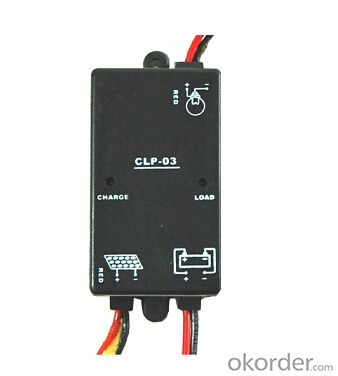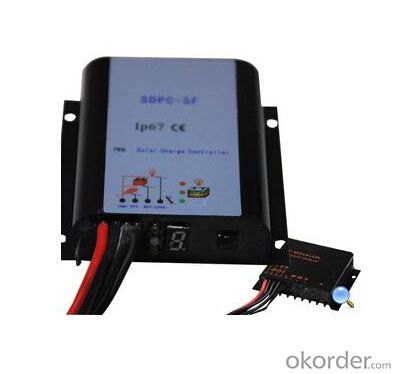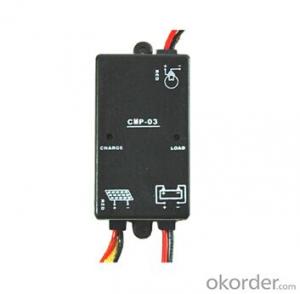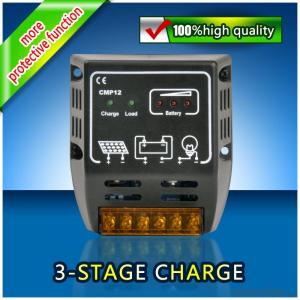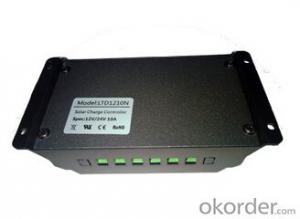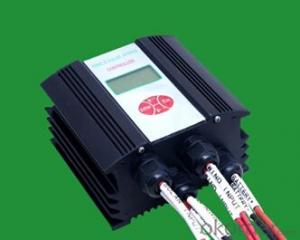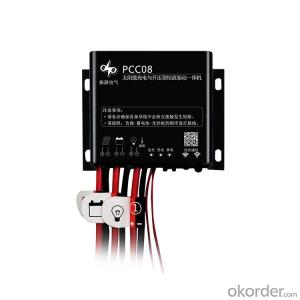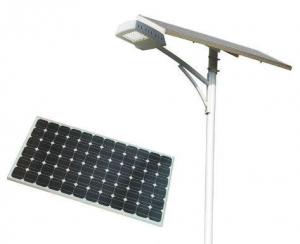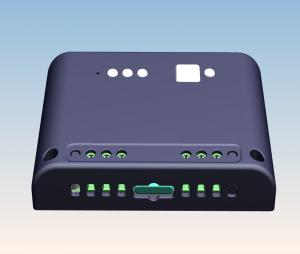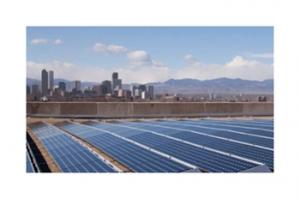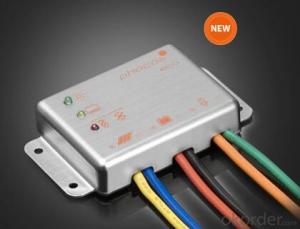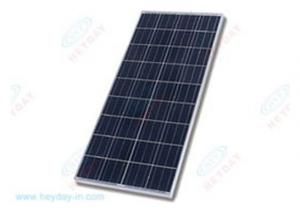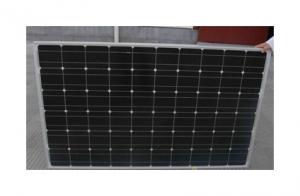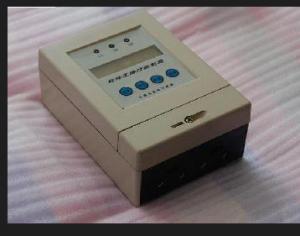Solar Streetlight Controller Model CLP03
- Loading Port:
- Shanghai
- Payment Terms:
- TT OR LC
- Min Order Qty:
- 10 unit
- Supply Capability:
- 200 unit/month
OKorder Service Pledge
OKorder Financial Service
You Might Also Like
1. Structure of Solar Streetlight Controller Model CLP03
This solar controller is designed for solar lawn lights, solar garden lights, mini solar street light, mini solar advertising light box and so on. The box of the controller is compact sealed with silicon. It is fit for 24W/12V or 36W/12V solar panels.
2. Main Features of Solar Charge Controller Model CLP03
· Smart size
· Light control function
· Temperature compensation during charging and discharging
3. Solar Charge Controller Model CLP03 Specification
Function:
1.Charge controlling: when the voltage of battery≧14.4V(with temperature compensation),controller will be shifted to floating-charge controlling, to prevent over-charging;
2.Discharge controlling: when the voltage of battery≦10.5V(with temperature compensation),controller will shut down the load,to prevent over-discharging;
3.Lighting controlling:when the voltage of solar panel≦5V(night is come on),after 30S,the load will be turned on ; when the voltage of solar panel≧5V(it is the dawn),the load will be shut down.
Rated Voltage | 12V |
Rated Charge Current | 1A or 3A |
Rated Discharge Current | 1A or 3A |
HVD (High Voltage Disconnection) | 14.4V |
Temperature Compensation | -3mV/℃/cell |
Size | 55×36×20mm |
LVD (Low Voltage Disconnection) | 10.5V |
LVR (Low Voltage Reconnection) | 12.0V |
Light Controller Mode | visibility 20m |
Temperature | -10- +40℃ |
Relative Humidity | ≦90% |
Net weight | 33g |
4. Solar Charge Controller Model CLP03 Images
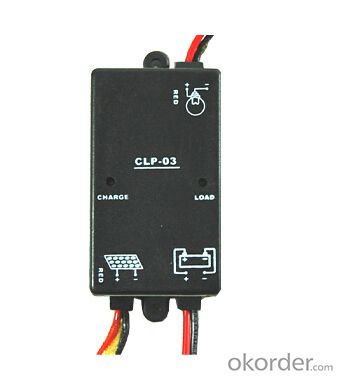
5. FAQ
a) How about your company?
We are able to supply 300,000 inverters and 60,000 solar energy charge controllers per year, the products are sold toward domestic and Europe, Australia Africa and other regions in great quantities.
b) How to guarantee the quality of the products?
The company is approved by the ISO9000 quality management system with its strict product quality control. The products for exportation pass the inspection of relevant foreign nations (CE, ROHS), and get high evaluation of the customers.
c) How long can we receive the product after signing Sales Confirmation?
Generally speaking, if there is enough quantity of finished products which can meet the clients’ requirement, we can manage the delivery within three to five working days according to the instruction of the payment terms in the Sales Confirmation; if the products need some time to get ready, we will arrange thedelivery as soon as possible after the manufacture.
- Q: How does a solar controller handle battery under-voltage disconnect recovery?
- A solar controller handles battery under-voltage disconnect recovery by monitoring the battery voltage and disconnecting the load when the voltage drops below a certain threshold. Once the battery voltage recovers and reaches a safe level, the solar controller re-connects the load to ensure the battery is protected from further discharge.
- Q: Can a solar controller be used with a solar-powered ventilation system?
- Yes, a solar controller can be used with a solar-powered ventilation system. A solar controller helps regulate the charging and discharging of batteries in a solar system, ensuring efficient use of solar energy. In the case of a solar-powered ventilation system, the solar controller can help manage the power supply to the system, ensuring optimal performance and extended battery life.
- Q: How do I integrate a solar controller with a smart home automation system?
- To integrate a solar controller with a smart home automation system, you need to ensure compatibility between the solar controller and the automation system. Most modern solar controllers come with built-in communication protocols like Wi-Fi or Zigbee, allowing them to connect to a smart home hub or directly to a smartphone app. To begin, you should check the manufacturer's documentation or website to determine if the solar controller supports integration with your specific automation system. If it does, follow the provided instructions to set up the connection. This usually involves connecting the solar controller to your home's Wi-Fi network or pairing it with the automation hub. Once connected, you can use the automation system's app or interface to monitor and control the solar controller. This may include monitoring energy production, setting charging schedules, adjusting battery settings, or receiving notifications about system status. Additionally, you can integrate the solar controller with other smart devices in your home, such as smart thermostats or lighting systems, to optimize energy usage based on solar availability. Remember to consult the manufacturer's instructions and seek assistance if needed to ensure a seamless integration between your solar controller and smart home automation system.
- Q: Can a solar controller be used with a solar-powered hydroponic system?
- Yes, a solar controller can be used with a solar-powered hydroponic system. A solar controller helps regulate and optimize the charging and discharging of the batteries in solar power systems. It ensures that the batteries are charged efficiently using solar energy and protects them from overcharging or discharging. In a solar-powered hydroponic system, a solar controller can be used to manage the power supply to the hydroponic lights, pumps, and other components, ensuring that they operate efficiently and effectively.
- Q: Can a solar controller be used with a wind turbine system?
- Yes, a solar controller can be used with a wind turbine system. A solar controller is designed to regulate the charging and discharging of batteries in a solar power system. Similarly, a wind turbine system also generates electricity that needs to be regulated and stored in batteries. Therefore, a solar controller can effectively manage the charging and discharging process in a wind turbine system as well.
- Q: What is the difference between a PWM solar controller and an MPPT solar controller?
- A PWM (Pulse Width Modulation) solar controller and an MPPT (Maximum Power Point Tracking) solar controller are both used in solar power systems to regulate the charging of batteries. The main difference between the two is in their charging efficiency and performance. A PWM solar controller works by rapidly switching the solar panel's output on and off to maintain a steady voltage for charging the battery. However, this method can result in energy loss and lower charging efficiency, especially in situations where the solar panel voltage is much higher than the battery voltage. On the other hand, an MPPT solar controller is designed to optimize the power output of the solar panel by dynamically adjusting the voltage and current to find the maximum power point. This allows the MPPT controller to efficiently convert and deliver more power to the battery, resulting in higher charging efficiency and better utilization of available solar energy. In summary, an MPPT solar controller is generally more advanced and efficient than a PWM solar controller, making it a preferred choice for maximizing the charging efficiency and performance of solar power systems.
- Q: What is the cost of a solar controller?
- The cost of a solar controller can vary depending on several factors such as brand, capacity, features, and quality. On average, a basic solar controller can range from $20 to $50, while more advanced models with additional functionalities can cost anywhere from $50 to $200 or more.
- Q: Can a solar controller be used in a solar-powered marine system?
- Yes, a solar controller can be used in a solar-powered marine system. A solar controller is designed to regulate the charging process of solar panels, ensuring that the batteries are charged efficiently and safely. Therefore, it can effectively manage the charging of batteries in a marine system, maximizing the utilization of solar power and extending battery life.
- Q: How does a solar controller prevent damage to the solar panels from electrical faults?
- A solar controller is an essential component in a solar panel system that helps prevent damage to the solar panels from electrical faults. It acts as a regulator or protector by monitoring and controlling the flow of electrical energy from the solar panels to the battery or load. One of the primary functions of a solar controller is to prevent overcharging of the battery. When the battery is fully charged, the solar controller detects this and cuts off the flow of electricity from the solar panels to the battery. This prevents excessive voltage levels that could potentially damage the battery or cause it to malfunction. By regulating the charging process, the solar controller safeguards the solar panels from any potential harm. Additionally, a solar controller also protects the solar panels from over-discharging. It monitors the battery's state of charge and prevents it from draining below a certain threshold. When the battery reaches the predetermined discharge level, the solar controller disconnects the load from the battery, ensuring that the solar panels are not subjected to excessive discharge currents that could potentially damage them. Furthermore, a solar controller plays a vital role in preventing electrical faults such as short circuits or reverse currents. It incorporates various protective features like fuses, circuit breakers, or diodes that safeguard against these faults. In the event of a short circuit or reverse current, the solar controller quickly detects the fault and interrupts the current flow, preventing any potential damage to the solar panels. In summary, a solar controller prevents damage to the solar panels from electrical faults by regulating the charging and discharging process, protecting against overcharging and over-discharging, and incorporating protective features to guard against short circuits or reverse currents. It acts as a reliable safeguard, ensuring the longevity and efficient operation of the solar panel system.
- Q: How do I maintain a solar controller?
- To maintain a solar controller, it is important to regularly inspect and clean the solar panels to ensure optimal efficiency. Additionally, check the wiring connections for any loose or damaged parts and tighten or replace them as needed. Keep the controller and its components protected from extreme weather conditions and clean any dust or debris on the controller itself. Regularly monitor the battery voltage and ensure that it is being properly charged by the solar controller.
Send your message to us
Solar Streetlight Controller Model CLP03
- Loading Port:
- Shanghai
- Payment Terms:
- TT OR LC
- Min Order Qty:
- 10 unit
- Supply Capability:
- 200 unit/month
OKorder Service Pledge
OKorder Financial Service
Similar products
Hot products
Hot Searches
Related keywords


